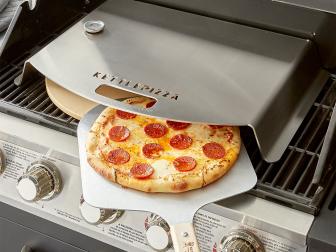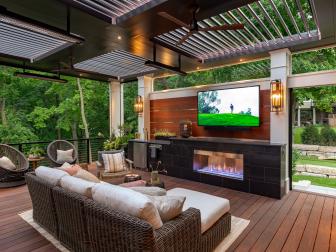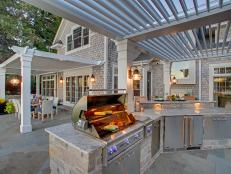How to Plan and Build an Outdoor Kitchen
Aesthetics are important but when it comes to building an outdoor kitchen, functionality and durability reign supreme. Read our professional tips to budget, plan and design an outdoor kitchen that will add value to your home and lifestyle.

Whether you're looking to build your outdoor kitchen or hire a team to help, be aware that it can require nearly the same amount of investment, time and resources as creating an indoor kitchen. But having that extra outdoor living space can provide years' worth of enjoyment and increase the value of your home.

Julie Soefer Photography
Of course, the benefits of creating an outdoor kitchen oasis are tangible. A party-ready patio equipped with a kitchen, dining area and comfortable seating can be as perfect for large gatherings as it can be for an intimate dinner for two. But, where does one begin to bring their backyard kitchen vision into fruition?
For homeowners wondering exactly how to build an outdoor kitchen, it's paramount to start with the basics: the location, the layout, the materials and the appliances. Learn how to build the outdoor kitchen of your Pinterest-board-dreams with our step-by-step guide below.
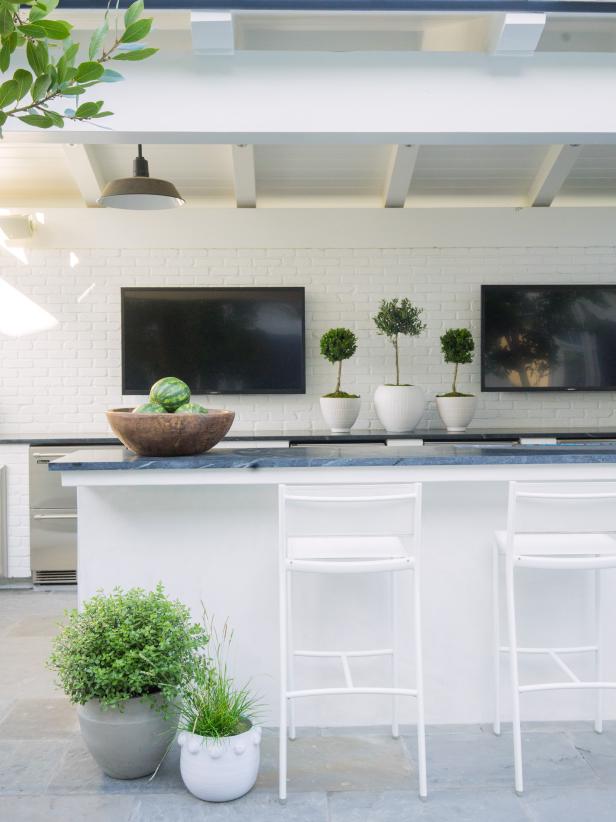
Lane Dittoe
Outdoor Kitchen Budgeting + ROI
The price range for building an outdoor kitchen varies from $5,000 for lower-end designs to well over $25,000 for luxury spaces and an average investment of $13,000. Yes, even budget-friendly outdoor kitchens will cost you a pretty penny, but we come bearing good news: An outdoor kitchen addition is your money well spent. The ROI, or return on investment, for building an outdoor kitchen is from 55% to 200% depending on your location and comparable homes in the area.
16 Steps to Boost Your Home's Value
Hint hint: Updated kitchens, stone veneer exteriors and converted attic bedrooms are money well spent.
How to Save Money on an Outdoor Kitchen
While handy homeowners may opt to design and build outdoor kitchens themselves, the average consumer looking to cut costs can also make smart purchasing decisions that make a DIY outdoor kitchen both affordable and practical. Think prefab rolling carts with grills that include extras like sinks, icemakers, lighting, stone-like counters and more. Or, if space permits, you may want to purchase separate carts based upon your needs, like a cart reserved solely for storage — or a combination countertop-sink option. Bottom line: Even if they aren't the result of your own elbow grease, DIY outdoor kitchens can still be cost-effective and efficient.
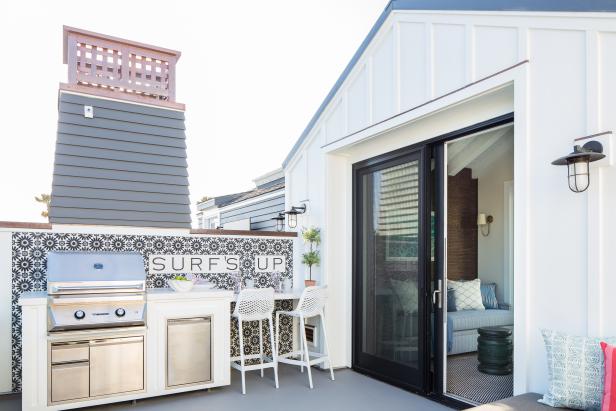
Ryan Garvin
Best Location for an Outdoor Kitchen
Location is everything. Before putting your design skills to work, assess your backyard and determine the location of the existing electric, plumbing and gas lines or determine where each will need to be to create the outdoor kitchen of your dreams. If you are working from scratch, we recommend consulting with a professional to ensure safety on all fronts before moving forward.
There are considerations when picking out the plot for your outdoor kitchen. Codes vary by municipality, so check with your town’s building department to find out rules about setbacks, regulations about how close you can build to your property line and what kind of permits you’ll need to file. Also, installing long runs of pipe and wire add up quickly. If you plan to run water, electricity or gas to your outdoor kitchen, keep it close to the utility source to cut costs.
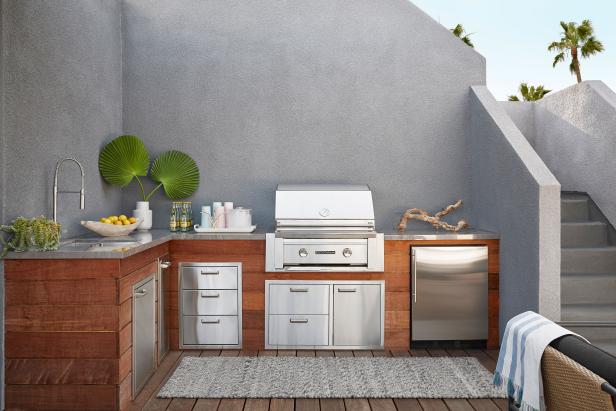
Zeke Ruelas
Choose a Layout
Once you nail down the general locale for your outdoor kitchen, it’s time to select a layout that will best serve your space and needs while remaining within your desired price point. There are several layouts to consider, and each type creates a unique cooking and entertaining experience.
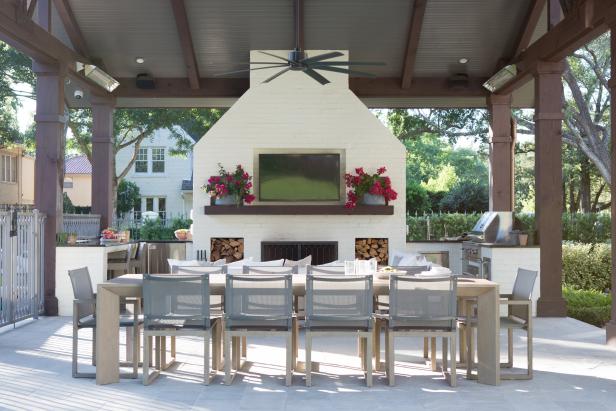
Kelli Durham Photography
Triangle Outdoor Kitchen
The most important feature of any kitchen is an efficient layout. Without one, it becomes doubly difficult to prepare, serve and enjoy meals in the space. The good news? There’s a tried-and-true layout you can use to ensure a balanced and efficient outdoor kitchen design: the triangle concept. In the kitchen triangle layout, the refrigerator, range or cooktop, and sink should form three points of a triangle, with no leg of the triangle measuring more than 10 feet. Additionally, the legs of the triangle should be unobstructed by structures like cabinets or a kitchen island. Following these guidelines maintains a natural flow that keeps the chef moving through prep, cooking and clean-up with ease.
Straight Line Outdoor Kitchen
Straight line kitchens are one of the most budget-friendly and space-saving layouts on this list. A straight line outdoor kitchen is like an indoor kitchenette, installed against a single exterior wall. The compact setup is ideal for small patios, keeping the floor plan open for entertaining. Note: It's paramount to use non-combustible materials to protect the integrity of your home's exterior wall. Consult with a professional to ensure results.
U-Shaped Outdoor Kitchen
If an expansive outdoor kitchen fit for year-round entertaining is your goal, a U-shaped layout is a perfect fit. The wraparound design easily accommodates large appliances like a grill, refrigerator, sink and bar in a visually balanced way. Bonus: The U-shape creates an inviting focal point for gathering with family and friends in any outdoor space.
L-Shaped Outdoor Kitchen
Like U-shaped kitchens, an L-shaped outdoor kitchen mimics the look of interior kitchens and includes major appliances like a grill, refrigerator and sink. The difference between the U and L-shaped kitchens is that a U-shaped layout uses three walls of cabinets while an L-shape uses two. This layout is our top pick if you want to create a kitchen with a large, luxurious look in an otherwise modestly sized outdoor space.
Outdoor Kitchen Islands
Kitchen islands are sought-after features in indoor and outdoor kitchens alike. This layout clusters the grill with other appliances in one compact central unit. A kitchen island layout is easily customized to suit any size or budget. Pro tip: Raise one side of your outdoor kitchen island to create distinct areas for cooking and entertaining.
Choose Materials With Climate in Mind
Selecting durable, climate-appropriate materials is the key to creating an outdoor kitchen that will stand the test of time. If you’re building an outdoor kitchen from scratch, the first step is choosing a frame material. Popular frame material options are wood, metal or concrete and each of these options has pros and cons.
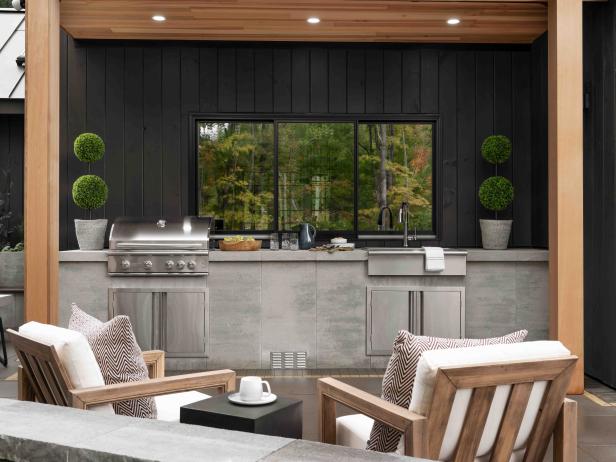
Robert Peterson, Rustic White
Wood Framing
Wood can be a great option if you plan on building your outdoor kitchen frame. It’s budget-friendly and easy to work with, but it does come with some risks. The three biggies to consider are rot, termite damage and combustibility. If you choose this route, it may be best to consult with a pro to ensure your structure is safeguarded as much as possible against danger and degradation over time.
Metal Framing
A metal outdoor kitchen frame is a solid option for homes with a dry climate as it will hold up to the elements. Metal framing is also easily accessible and holds weight like a champ. However, if you live in a humid climate or one that experiences regular freezing, you should consider another option because moisture leads to corrosion and instability over time.
Concrete Block Framing
Concrete blocks are the other go-to option for outdoor kitchen framing because they are non-combustible, hold up against all climates and will not break down over time. The main drawback of a concrete block frame is that it requires skilled professionals and heavy machinery to get the job done. In other words? Concrete is expensive.
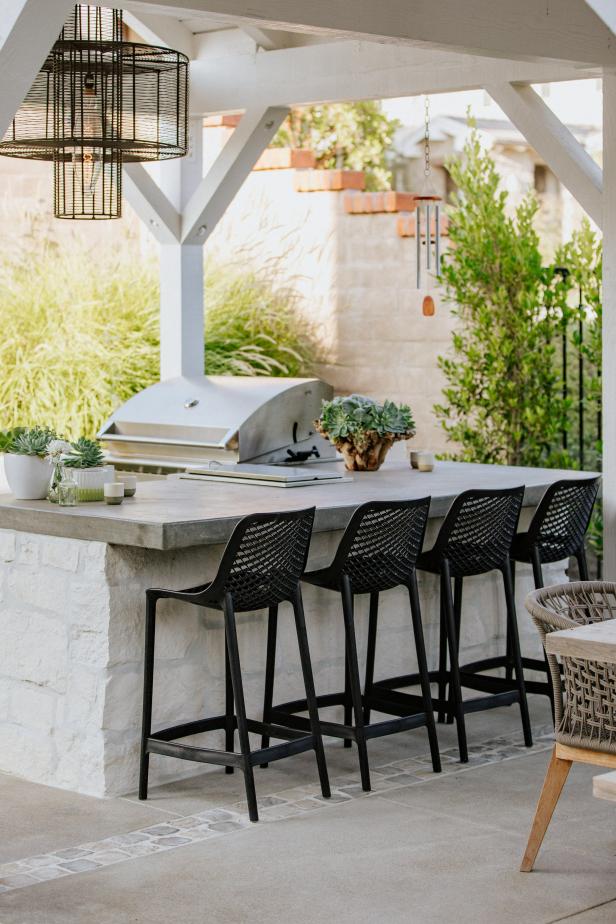
Brett Hilton
Consider Your Cladding Materials
Cladding materials are applied to the frame of your outdoor kitchen that will bring your design to life. Popular outdoor kitchen cladding materials include stone, brick, tile and stucco. Climate plays a part when selecting your cladding material, just as it does with the framing.
Stucco is a go-to option for dry, hot climates like those found in California or Arizona but is not a stable option for high-humidity locations. Tile offers endless possibilities to showcase your style, but it’s often fragile and requires consistent maintenance to ensure longevity. Stone and brick are sought-after and stable but can be quite pricey. If you love the look of stone or brick but can’t stomach the price tag, look for a manufactured veneer to achieve the same stately results at a fraction of the price.
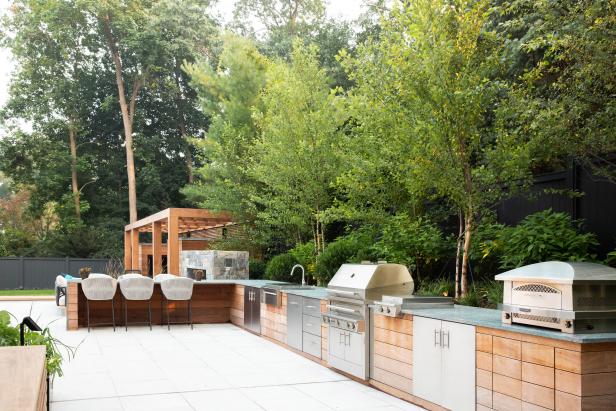
Arborway Studio
Choose Outdoor-Grade Appliances
The ever-evolving elements are not kind to appliances and that’s why it’s crucial to invest in outdoor-grade appliances for your alfresco kitchen. Yes, the rumors are true: Outdoor appliances are expensive. And, after window shopping, it’s going to be very tempting to cut corners with a cheaper option. But a word to the wise? Don’t! It’s important to think long-term and invest in a grill, oven, smoker and/or refrigerator that will last for years to come and indoor-grade appliances will not stand a chance.
One of our go-to money-saving tips for outfitting an outdoor kitchen is choosing appliances that fit your lifestyle. If your family looks forward to make-your-own pizza night each week, you can skip the fancy meat smoker and treat yourself to a wood fire pizza oven instead.
The Best Indoor and Outdoor Pizza Ovens for Every Budget
Take a break from the frozen stuff, and treat yourself to gourmet pizza made in a quality oven.
What You Need to Know About Hanging a TV Outside
Get tips for installing an outdoor TV on your porch, by the patio or near your swimming pool.













